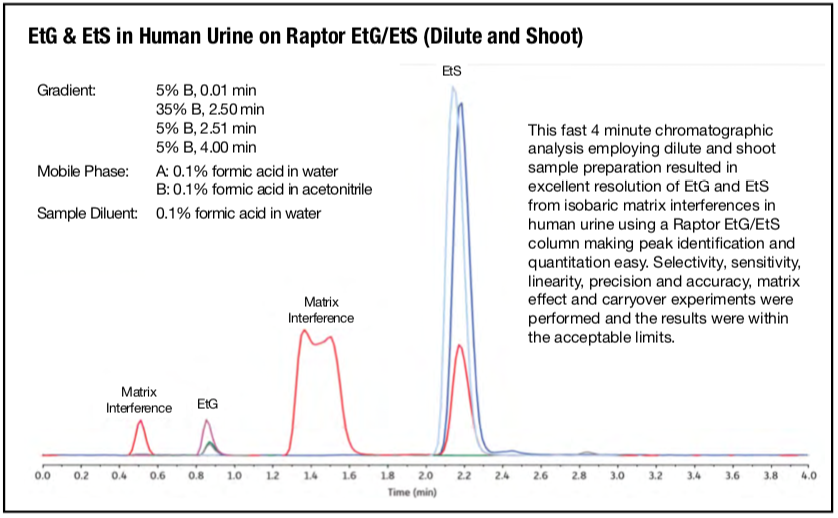Posted by Chrom Tech on 16th Oct 2025
Successful Strategies for the Analysis of EtG and EtS in Urine
Alcohol-impaired driving continues to be a serious public safety issue in the United States. A report from the National Highway Traffic Safety Administration (NHTSA) shows that nearly one-third of all traffic fatalities involve alcohol impairment. Individuals charged with driving under the influence (DUI) are often required to complete court-mandated substance abuse evaluations, which frequently include alcohol urinalysis screenings.
EtG and EtS: Key Biomarkers for Alcohol Detection
Ethyl glucuronide (EtG) and ethyl sulfate (EtS) are direct metabolites of ethanol and serve as reliable biomarkers for identifying alcohol consumption long after ethanol itself is no longer detectable in the body. EtG and EtS testing provides forensic and clinical laboratories with extended detection windows—up to three days after drinking—making them particularly valuable for monitoring abstinence and compliance.
According to Restek, both EtG and EtS demonstrate strong chemical stability, high analytical specificity, and excellent reproducibility. This combination ensures dependable results even in challenging forensic and toxicological testing environments.
Fast and Reliable LC-MS/MS Analysis with Restek Raptor EtG/EtS Columns
The Restek Raptor EtG/EtS LC column enables laboratories to perform a fast, 4-minute “dilute-and-shoot” LC-MS/MS analysis for EtG and EtS quantification. This method minimizes sample preparation time, supports high-throughput workflows, and maintains robust analytical precision.
This streamlined LC-MS/MS workflow not only saves valuable instrument time but also reduces potential human error in sample processing, resulting in improved productivity and consistency for forensic and clinical toxicology labs.

Advantages of the Restek EtG/EtS LC Column
- Rapid 4-Minute Method: Increases throughput without compromising accuracy.
- Simple Dilute-and-Shoot Workflow: Reduces labor and eliminates complex extraction steps.
- Enhanced Stability: Provides consistent peak shape and reproducibility for EtG and EtS detection.
- LC-MS/MS Compatibility: Optimized for use with modern tandem mass spectrometry systems.
Applications in Forensic and Clinical Testing
EtG and EtS testing is used extensively in forensic toxicology, probation monitoring, rehabilitation programs, and workplace compliance. These biomarkers provide a non-invasive and highly reliable method for detecting recent alcohol use, offering improved accuracy over traditional ethanol assays.
Partner with Chrom Tech
Chrom Tech is a Minnesota-based worldwide distributor of chromatography and mass spectrometry supplies. We offer HPLC vials, well plates, syringe filters, solvent waste containers, and other essential consumables to support analytical testing workflows. Contact Chrom Tech to equip your laboratory for accurate and efficient EtG/EtS analysis.
Frequently Asked Questions
What are EtG and EtS used for in alcohol testing?
EtG (ethyl glucuronide) and EtS (ethyl sulfate) are direct metabolites of ethanol that remain detectable in urine for up to 72 hours. They are used to confirm recent alcohol consumption even when ethanol is no longer present in the bloodstream.
Why use the Restek Raptor EtG/EtS column for LC-MS/MS?
The Restek Raptor EtG/EtS LC column delivers a 4-minute dilute-and-shoot method optimized for high-speed LC-MS/MS analysis, providing excellent retention, reproducibility, and throughput for forensic and clinical testing laboratories.
How reliable are EtG and EtS as alcohol biomarkers?
Both EtG and EtS offer strong analytical specificity, excellent stability, and extended detection windows, making them among the most reliable biomarkers for detecting recent alcohol use.

